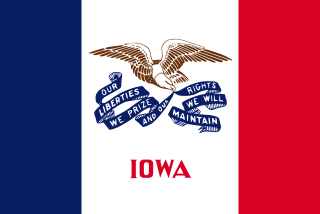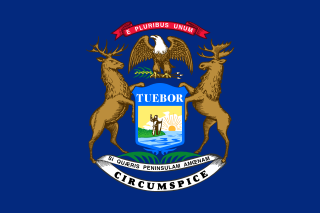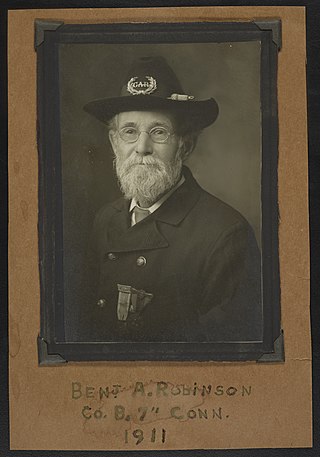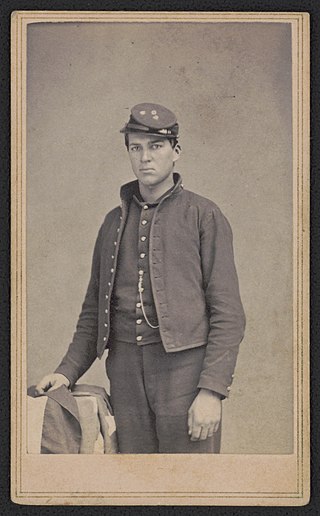Related Research Articles
The 3rd Wisconsin Cavalry Regiment was a volunteer cavalry regiment that served in the Union Army during the American Civil War.
4th Michigan Cavalry Regiment was a regiment of cavalry in the Union Army during the American Civil War fighting in the western front as part of the Army of the Cumberland. It was noted as being the regiment that captured the fleeing President of the Confederate States of America, Jefferson Davis, as the Confederacy collapsed in the spring of 1865.
David Southard was a Union Army soldier during the American Civil War who received America's highest military decoration the Medal of Honor for his actions at the Battle of Sailors Creek
The 1st Wisconsin Cavalry Regiment was a volunteer cavalry regiment that served in the Union Army during the American Civil War. The regiment is most notable as one of two cavalry regiments credited with the final capture of Confederate president Jefferson Davis on May 10, 1865.
The 10th New Jersey Infantry Regiment was a regiment was organized under the provisions of an Act of Congress approved July 22, 1861, and by authority issued by the War Department. It was created to recruit from residents of the State of New Jersey, but was not under the control or supervision of the State authorities. It was originally known as "Olden Legion" after New Jersey Governor Charles Olden.

The 4th Iowa Cavalry Regiment was a cavalry regiment that served in the Union Army during the American Civil War.

The 5th Michigan Cavalry Regiment was a cavalry regiment that served in the Union Army during the American Civil War. It was a part of the famed Michigan Brigade, commanded for a time by Brigadier General George Armstrong Custer.
The 7th Pennsylvania Cavalry Regiment was a cavalry regiment that served in the Union Army during the American Civil War. The unit was frequently referred to as "80th Regiment".

The 106th New York Infantry Regiment was an infantry regiment in the Union Army during the American Civil War.

The 7th Connecticut Infantry Regiment was an infantry regiment that served in the Union Army during the American Civil War. Because it was in the same brigade as the 7th New Hampshire Volunteer Regiment, both regiments were often jointly called the '77th New England'.
The 2nd Ohio Cavalry Regiment was a cavalry regiment that served in the Union Army during the American Civil War.
The 13th Ohio Cavalry Regiment was a cavalry regiment that served in the Union Army during the American Civil War.

The 6th Regiment New York Heavy Artillery, U.S. Volunteers, the "Anthony Wayne Guard", was an artillery regiment of the Union Army during the American Civil War. It was originally mustered in as the 135th New York Volunteer Infantry Regiment, and served as both artillery and infantry.
Captain Hugh P. Boon was an American soldier who fought in the American Civil War. Boon received the country's highest award for bravery during combat, the Medal of Honor, for his action during the Battle of Sailor's Creek in Virginia on 6 April 1865. He was honored with the award on 3 May 1865.

Alexander Calvin Elliott was a United States soldier who fought with the Union Army during the American Civil War as a sergeant with Company A of the 1st Pennsylvania Cavalry. He received his nation's highest award for valor, the U.S. Medal of Honor, for his actions at Paines Crossroads, Virginia on April 5, 1865. That award was conferred on May 3, 1865.
The 7th Regiment Indiana Cavalry was a cavalry regiment that served in the Union Army during the American Civil War.

The 1st Massachusetts Volunteer Cavalry Regiment was a cavalry regiment that served in the Union Army during the American Civil War.

The 2nd New York Cavalry Regiment, officially known as the 2nd Regiment, New York Volunteer Cavalry, was a unit of the Union Army during the American Civil War. It served with the Army of the Potomac and fought in Stoneman's 1863 raid, the Wilson–Kautz Raid, and the Battle of Appomattox Station.
References
- ↑ William Halstead, Biographical Directory of the United States Congress . Accessed October 31, 2007.